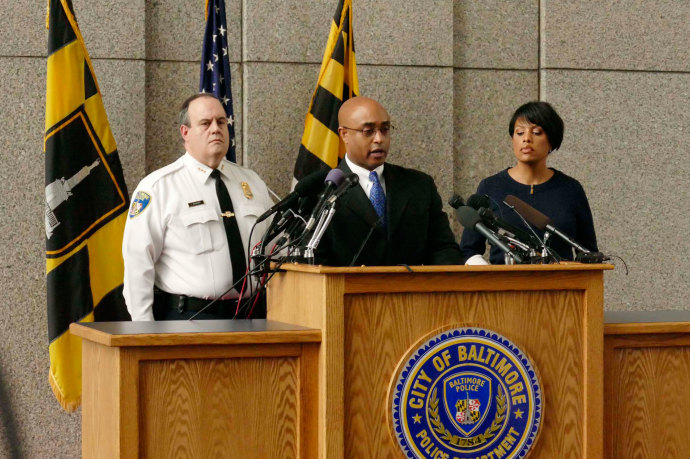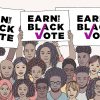By Amy Davidson
 Credit Photograph by Kevin Richardson/The Baltimore Sun via AP
Credit Photograph by Kevin Richardson/The Baltimore Sun via AP
Two Sundays ago, just after eight-thirty in the morning, four Baltimore police officers were patrolling the streets around the Gilmor Homes housing project when, as the department’s deputy chief, Jerry Rodriguez, said at a press conference yesterday, they “made eye contact” with a twenty-five-year-old man named Freddie Gray. Gray ran, and after a brief chase on foot the officers caught him. They said they found a switchblade in his pocket. Carrying a spring-operated knife within Baltimore city limits can, in certain circumstances, be illegal, although the police commissioner said at the press conference, “Just running—there is no law against running.” They placed Gray under arrest, one officer later wrote in a charging document, “without force or incident.” Arrests are frequent occurrences in that part of Baltimore, and yet there was something about this arrest that, for some bystanders, qualified as an “incident,” and a disturbing one. There is a cell-phone video of the scene, which has been posted by the Baltimore Sun and others, in which a woman can be heard calling to the officers, “Hey, his leg looks broke! Look at his [bleeped] leg!” A man is seen walking toward the police, seemingly pointing out the same thing: as the officers half-march, half-drag Gray to a van, his legs are dragging on the ground. Gray is screaming, although it sounds more like a cry than like words; the police don’t pause. The woman, sounding more alarmed, shouts,
• • •Freddie Gray’s leg was not broken, as it turned out; this was determined in an autopsy after he died, on April 19th, after a week in a coma. Instead, sometime between his arrest and the moment, forty-five minutes and a winding van ride later, when a medic was called at the station, he had suffered severe spinal injuries. His lawyer told the Baltimore Sun that three of his vertebrae had been crushed, along with his voice box. “We know the injuries that Mr. Gray sustained,” Deputy Chief Rodriguez said at the press conference. “What we don’t have, at this point, is how Mr. Gray sustained those injuries.” The police also knew, he said, that “when Mr. Gray was placed inside that van, he was able to talk—he was upset. And, when Mr. Gray was taken out of that van, he could not talk and he could not breathe.” Rodriguez added, “I am deeply troubled by this.”
According to a police timeline, Gray, despite his distress, was able to ask the officers for an inhaler as he got into the van. It’s not clear whether he was given one. He was placed alone, the police say, in the back of the van, in one of two chambers separated from the officers by metal dividers. Then the van drove for more than half an hour. Based on the timeline, there appears to have been at least three opportunities to have helped him. Four minutes into the ride, according to Rodriguez, the driver reported that he “believes that Mr. Gray is acting irate,” and a minute later the van stopped. But the only result was that the officers did some paperwork and put leg irons on Gray. Thirteen minutes later, there was some sort of check on Gray, after which the police stopped to pick up another prisoner. (That prisoner was also separated from Gray by the dividers.) Before the van drove off, there was, the police say, “some communication with Mr. Gray”—whether it was verbal or not isn’t yet clear.
One of the many questions yet to be answered is whether Gray was wearing some sort of seat belt, as is required. The injuries he had were not casual ones; the Sun spoke to medical experts who said that they would have been caused by serious trauma. Was an injury to his back the reason that witnesses thought his legs didn’t work, or was he injured in the van? At the very least, anyone trained as a police officer would—or should—know that a spinal injury can be exacerbated if someone is moved improperly, whether by being dragged or bumped around in a moving vehicle. Gray was in far worse shape at the end of the ride than he was at the beginning, which makes the question of what happened in the van an urgent one. It was, in effect, a black box that Gray entered. For many people in this country, that is too often a summary of their experience with the criminal-justice system as a whole. It is one of the reasons that people run.
The tone of the press conference, at which Rodriguez was joined by Police Commissioner Anthony Batts and Mayor Stephanie Rawlings-Blake, was repentant. “I understand the community’s frustration,” Rawlings-Blake, who, like Gray, is black, said. “I understand it because I’m frustrated. I’m angry that we are here again. That we have had to tell another mother that their child is dead.” Six police officers have been suspended, pending an investigation. Even before Gray’s death, Batts had asked the Department of Justice to look into his force’s policing practices. “That request followed a Baltimore Sun investigation that found taxpayers had paid nearly $6 million since 2011 to settle more than 100 lawsuits alleging police brutality and other misconduct,” the newspaper noted. The officials emphasized that Baltimore was not Ferguson. What that means, as the experience of North Charleston shows, is that what tends to provoke civil unrest is not simply the deaths of black men at the hands of the police but a sense that political institutions are indifferent or unresponsive to incidents of brutality. Accountability is a necessary response.
Some attention has been given to police perceptions of threat—of how a black man in a bad neighborhood can seem to an officer, and how different that perception can be from what the man’s neighbors know of his character. Another question in the Gray case concerns how the police heard a black man’s screams, and what they meant to them: that he was “irate” and “upset,” as though he were being willfully difficult, an angry man who needed leg irons, not that he was in pain and needed a doctor. And yet it was the distinct sound of his voice that the bystanders remembered. “Oh, you could hear that child hollering,” an older woman named Alethea Booze told the Sun. “He was screaming and hollering so bad. It hurts me, ’cause I’ve got boys, too.”















